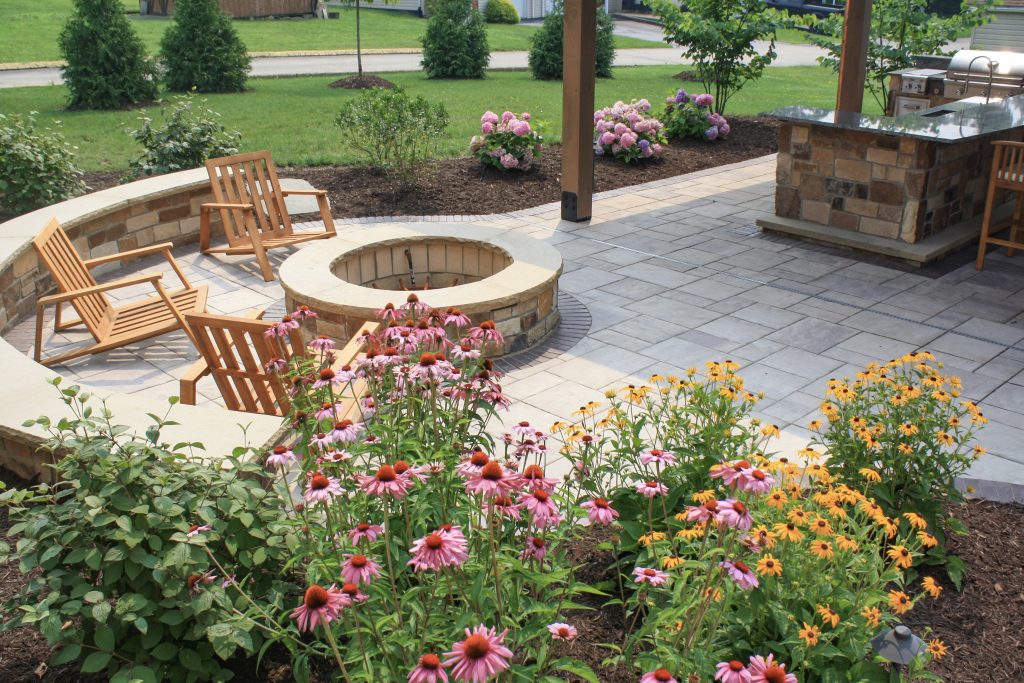
If you want your Pittsburgh landscape to thrive in every season while reducing maintenance and supporting the local environment, native plants are key.
Native plants, those naturally adapted to Western Pennsylvania’s unique soil, weather, and wildlife, are ideally suited to handle our region’s cold winters, humid summers, and rolling terrain. By choosing native landscaping, you can create a beautiful, low-maintenance outdoor space that helps conserve water, attract pollinators, and supports the local ecosystem.
Many people have probably heard the term ‘native plants’, but what are native plants, and why are they important to our environment? Native plants are ones that naturally grow in a specific environment. Neighboring regions often have overlapping species of native plants; however, there is a category of native plants known as ‘endemic plants’. Endemic plants are species that have adapted to an environment to the point that they become their own variety. This new variety of species isn’t found naturally anywhere else in the world, making it a notable addition to the environment in question.
Non-native plants are those that are transported to different parts of the world for various reasons. Some of these reasons include that they are intended for food, resources, or aesthetic purposes. These plants, however successful they may grow, are not considered native plants.
While the intent behind this is often good, in some cases, the non-native plants can do more harm than good.
Native plants are essential to our environment for various reasons. In general, plants grow in a specific area for a reason; it’s the perfect growing conditions for the plant. Landscape architects recommend using native plants for planting designs because they will grow reliably. This is because the growing conditions for that plant are perfect. For example, a plant that typically grows well in the desert won’t grow well in your backyard without requiring a substantial amount of maintenance. A plant that naturally occurs in the forests around your home will grow beautifully and, once it has established itself, will require very little upkeep. Adding native plants also benefits both the consumer and the environment, as it significantly reduces energy and water usage.
The next reason is biodiversity. Biodiversity is essential for maintaining a balanced ecosystem, which in turn is crucial for sustaining the ecosystem’s flora and fauna, as well as for mitigating the effects of climate change. Plants and animals alike need the ecosystem to find a harmonious balance for survival. Animals count on a variety of plants for shelter and food. Some people may think, “Well, I don’t want to plant a native plant if deer are going to make a meal out of it”.
While that can be a potential issue, several plants have developed their own defense mechanisms against such threats. In addition to maintaining a balanced ecosystem, biodiversity plays a vital role in helping to mitigate climate change. Efficient use of resources, like water and soil nutrients, is a significant aspect of climate change. Plants can also contribute to the Earth’s heating and cooling processes, and maintaining the right balance of plants in the ecosystem can help regulate the desired climate.
Another critical aspect of the environment where native plants play a crucial role is in the soil. Soil is essential because it serves as the foundation for all plant growth and development. All our food comes from the soil, so it must be correctly cared for. For example, some plants can deplete the micronutrients in the soil. However, native plants growing in native soil are adapted to thrive without depleting the soil or requiring fertilizer.
Another reason native plants are essential for soil health is that they can help prevent soil erosion. Their root density can help secure the soil in place and prevent it from eroding during runoff events.
Non-native plants aren’t always harmful, but in many cases, they can be. It’s important to know the risks that non-native plants can pose to the environment. The first, as mentioned before, is that they can require vastly different growing conditions, which results in large amounts of upkeep. It’s also interesting to note that a plant that is considered an annual in western Pennsylvania may be considered a perennial in a tropical environment.
In situations where this is not the case, the plant requires immense amounts of upkeep to grow well; however, the plant in question can actually thrive in a non-native environment. The non-native plant may grow uncontrollably and become invasive, choking out native plants that benefit the environment and potentially damaging it.
Anyone can research to discover which plants are native and non-native, making informed decisions before choosing plants for their landscape. However, that can take a lot of time, which most people don’t have. Landscape Architects have received a degree. Part of the requirements for earning this degree include studying native and non-native plants, as well as how they interact with the environment.
Landscape Architects are experts in distinguishing between native and invasive plants and can ensure that we won’t plant anything that can harm the environment in your backyard. So, when planning your plants this summer, consider doing a little research—or better yet, consult a professional.
Adding native plants to your Pittsburgh landscape isn’t just an eco-friendly decision—it’s an investment in the long-term beauty and health of your outdoor space. Native species naturally thrive in our local climate, reduce water use, and support pollinators like bees and butterflies that are essential to Western Pennsylvania’s ecosystem.
If you’re ready to design a sustainable, low-maintenance landscape that feels right at home in the Pittsburgh region, our team of experienced landscape architects is here to help. Check out our project Infinite Possibilities to see how we use native plants in our designs!
Contact us today to schedule a consultation and start planning your native plant landscape—crafted to complement both your property and the natural beauty of Southwestern Pennsylvania.